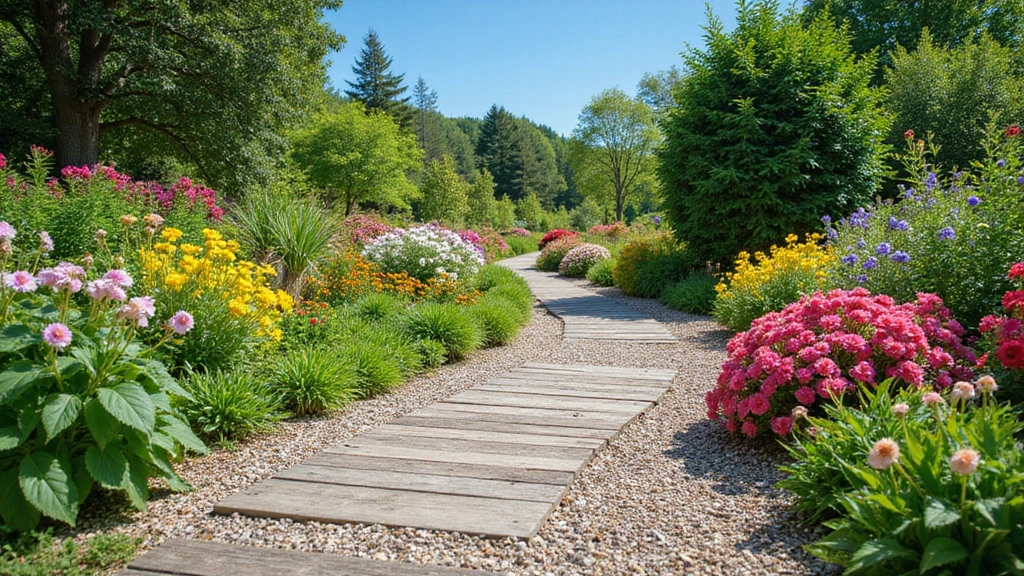Gardening is a delightful way to express your creativity while embracing the beauty of nature.
One of the most enchanting elements of any garden is the path that weaves through it, guiding visitors on a journey filled with color, scent, and texture.
These sustainable garden path ideas don’t just serve a functional purpose; they enhance your landscape design and add charm and character to your outdoor spaces.
Let’s explore 30 unique garden path ideas that incorporate innovative materials, eco-friendly practices, and artistic flair to transform your garden into a stunning oasis.
1. Recycled Wood Plank Pathways
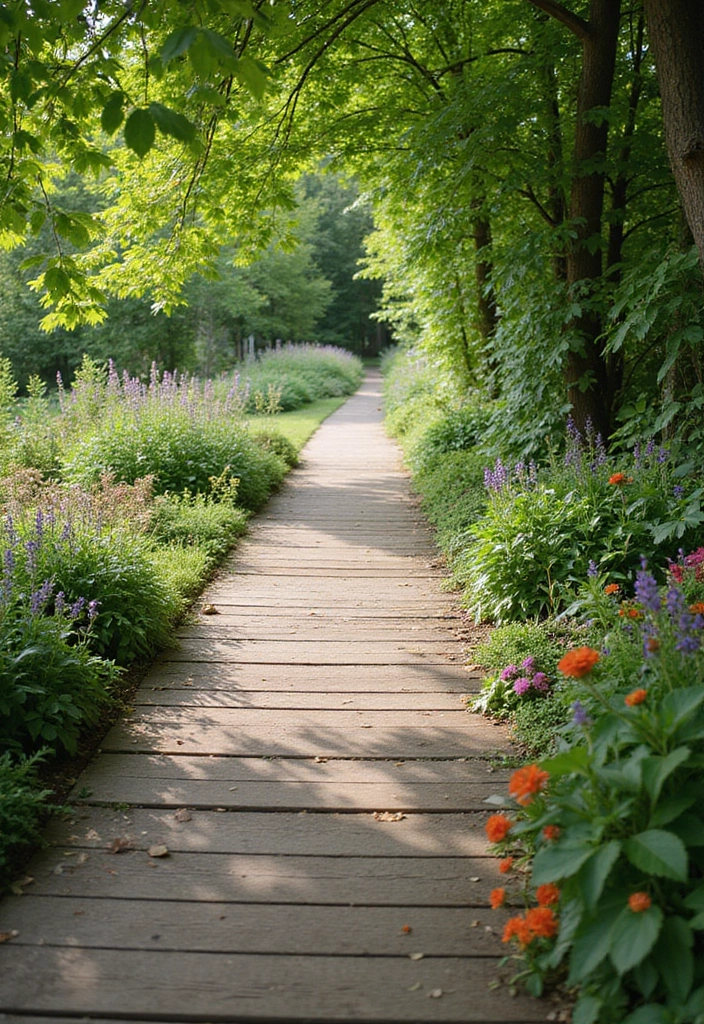
Recycled wood planks not only add a rustic charm to your garden paths but also promote sustainability by giving new life to discarded materials.
These pathways can be easily crafted by cutting timber into planks or using old pallets. The beauty lies in their organic look, which harmonizes perfectly with greenery.
You can create a simple, linear layout or a meandering design—whatever suits your garden style.
Some tips:
– Ensure the wood is treated to withstand the elements.
– Incorporate moss or creeping plants around the edges for an enchanting touch.
– Use natural wood stains for added durability and aesthetic value.
These paths can act as a delightful contrast to vibrant flowers or even a serene backdrop for garden sculptures.
2. Stone and Gravel Mix
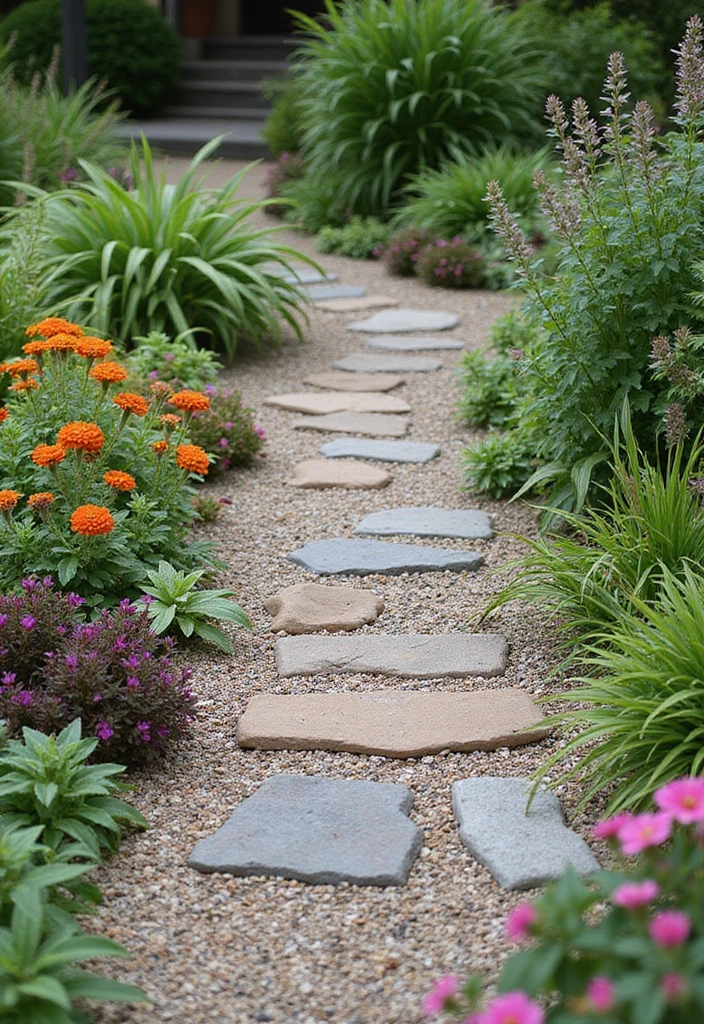
Combining stones and gravel can lead to a visually appealing and eco-friendly path.
This style allows for excellent drainage, reducing puddles after rain and keeping the path dry. The contrast of textures adds to the overall aesthetics.
Consider using larger stones for borders and finer gravel in between for a naturally beautiful look.
Some points to consider:
– Choosing local stones can reduce your carbon footprint.
– Utilize a mix of colors and sizes for interest.
– Add stepping stones for a whimsical, fun touch!
The crunching sound of gravel underfoot enhances the garden experience, making it feel more like a tranquil retreat.
3. Eco-Friendly Brick Walkways
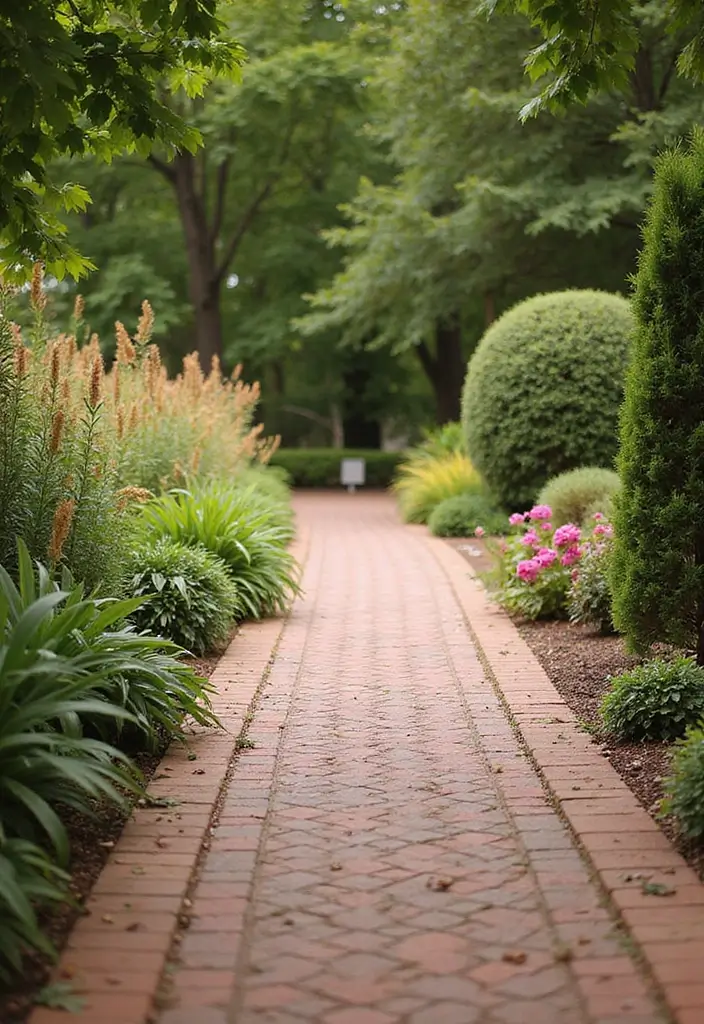
Brick walkways can add a classic touch to any garden while being environmentally friendly.
Using reclaimed bricks not only reduces waste but also allows you to create unique patterns that enhance your landscape design. The warmth of the bricks contrasts beautifully with greenery, creating an inviting path.
for installation:
– Lay bricks in various patterns like herringbone or basket weave for visual intrigue.
– Incorporate plants in the joints for a softer look.
– Regular maintenance keeps them looking fresh and vibrant!
A brick path can lead to a cozy seating area or a secret garden nook, inviting exploration.
4. Living Pathways with Ground Cover
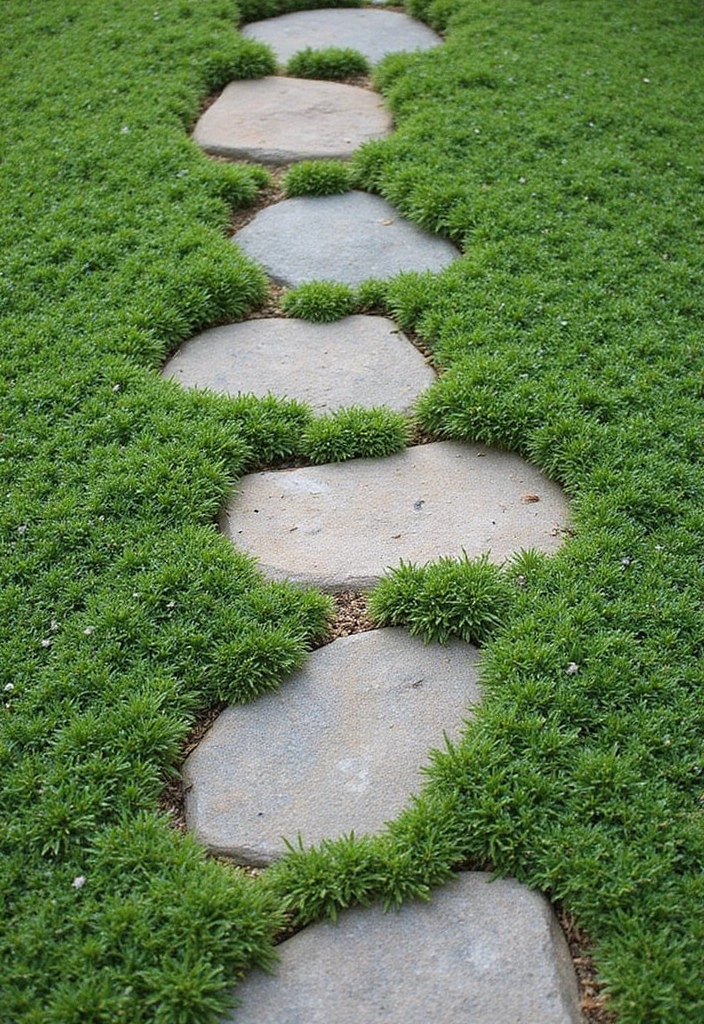
Imagine walking along a path that’s alive! Living pathways made with ground cover plants like thyme or creeping phlox are not only practical but also stunning.
These plants naturally fill in gaps, creating a soft, green carpet underfoot. They also release fragrant aromas when stepped on, enhancing the sensory experience of your garden journey.
Considerations include:
– Choosing plants that thrive in your local climate and soil conditions.
– Intermixing with stones for structure and aesthetics.
– Depending on where you live, opt for native plants to attract local pollinators.
This idea brings a refreshing, delightful vibe to the garden while promoting biodiversity.
5. Glass Jar Path Lighting
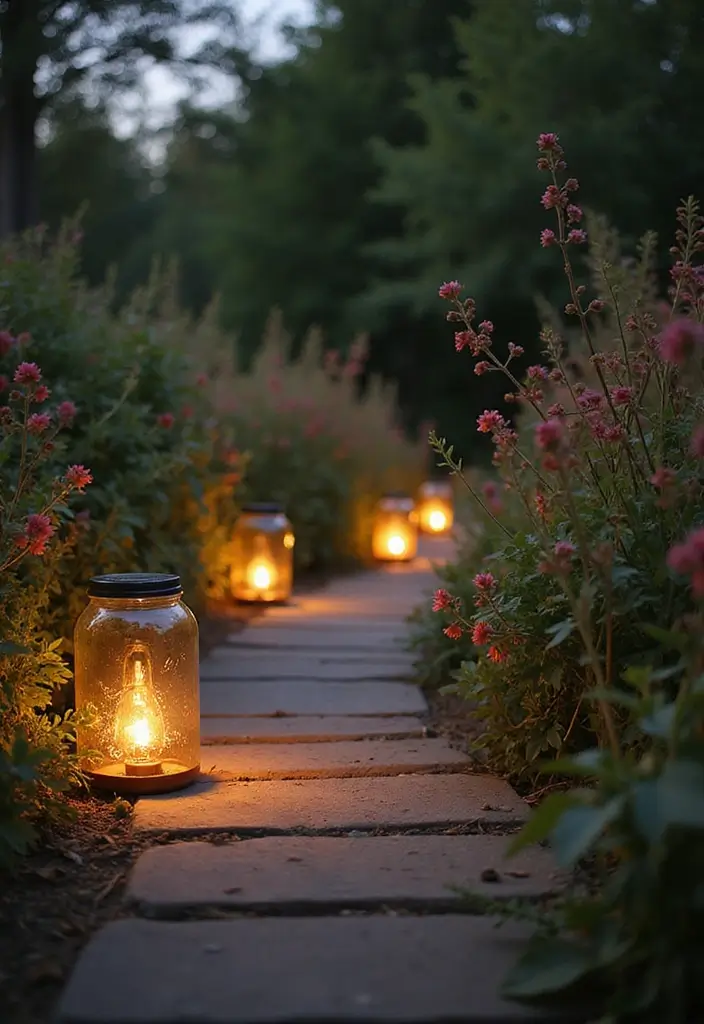
Illuminate your garden path with glass jar lights for a magical touch at night.
Old mason jars or decorative glass containers can be transformed into charming lanterns, guiding the way with soft, ambient light. Filling them with fairy lights, candles, or solar lights can make your garden feel like a whimsical fairytale.
Here’s how to create this look:
– Use different sizes of jars for varying heights.
– Arrange them along the edges of your pathway for a cohesive look.
– Ensure they are securely placed to withstand windy nights.
The gentle glow creates a serene atmosphere, perfect for evening strolls and gatherings.
6. Reclaimed Tile Paths
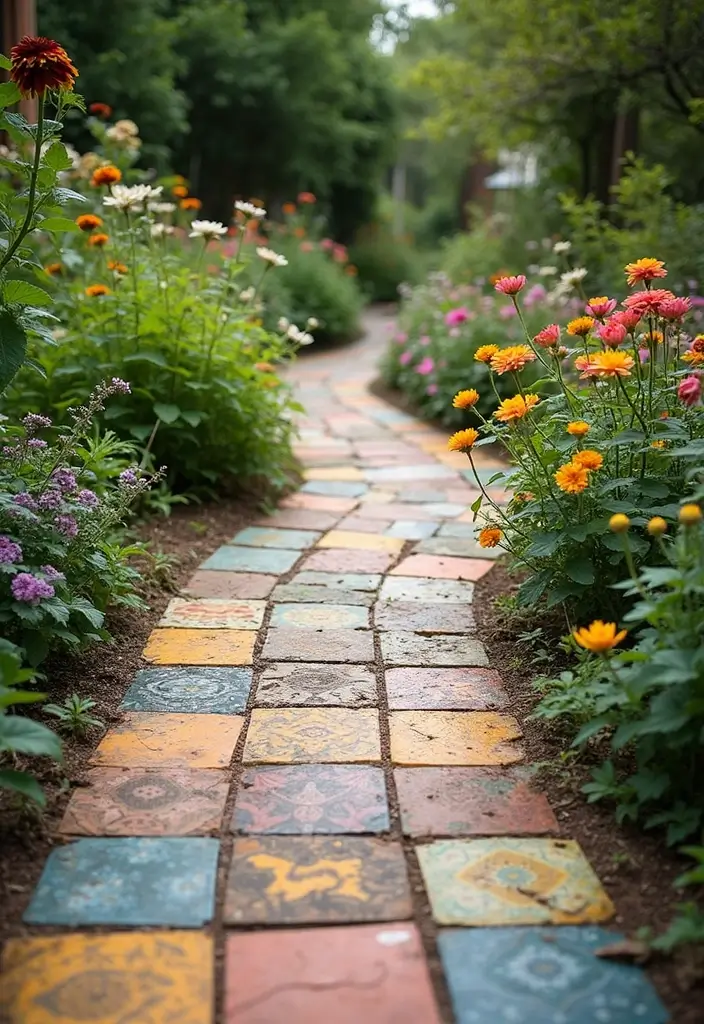
Reclaimed tiles offer a splash of color and creativity to any garden path.
Gathering tiles from old renovations or thrift stores can lead to a stunning mosaic effect, adding a personal touch that’s uniquely yours. The tiles can be arranged in intricate patterns or left in a more random style—whatever fits your garden vibe.
include:
– Make sure the tiles are clean and intact before use.
– Use sand or a concrete mix to secure them in place.
– Consider contrasting colors to make the path pop!
Such paths can serve as eye-catching focal points, drawing attention to the beauty of your garden.
7. Pebble Mosaic Designs
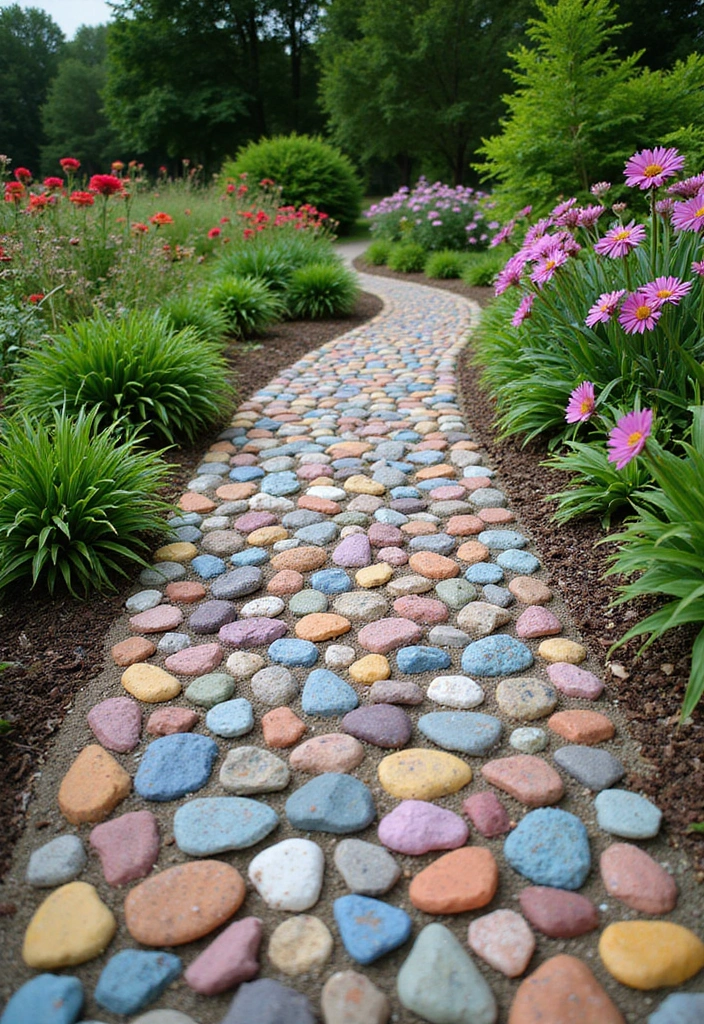
For an avant-garde approach, think about creating pebble mosaics.
These paths are artworks in themselves, combining different shapes, colors, and sizes of pebbles to form intricate patterns or images. A mosaic path can be a true statement piece in your garden, showcasing your creativity and passion for art.
To create your own pebble mosaic:
– Sketch your design on paper first.
– Lay down a base for stability and drainage.
– Place pebbles firmly and fill the gaps with sand or grout for better longevity.
The result is not just a pathway but a beautiful garden feature that delights the eye.
8. Sunken Pathways
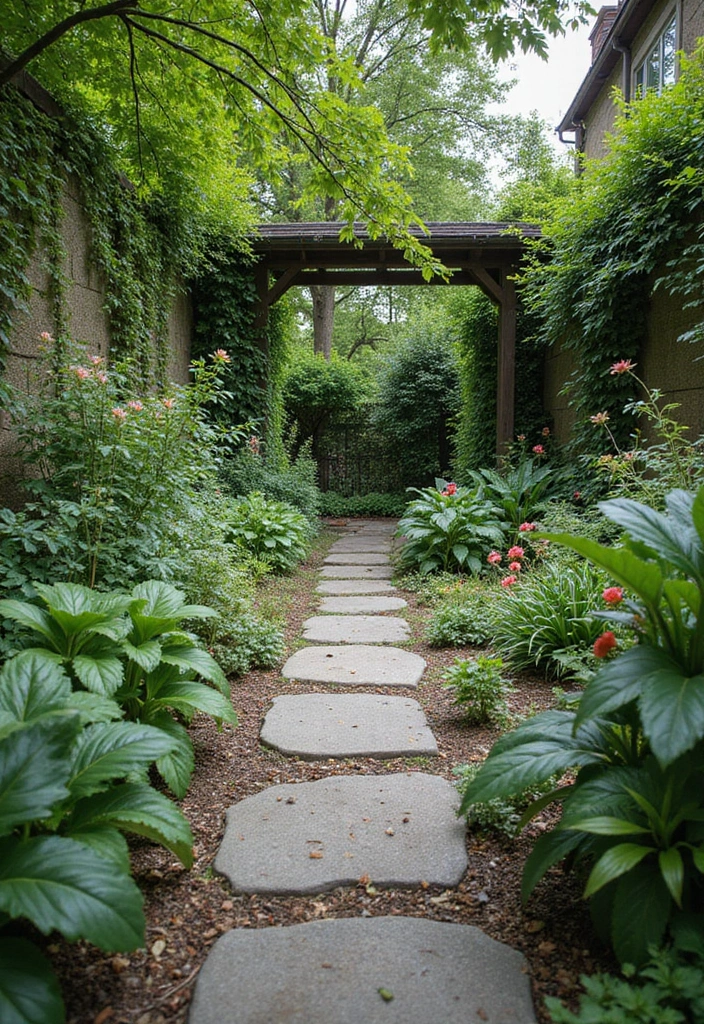
Take a step downward into your garden with sunked pathways.
By creating paths that are lower than the surrounding area, you can craft a unique garden space that feels more intimate and secluded. This design can help define areas within your garden while promoting better drainage.
Some suggestions:
– Use natural stone or gravel to create the path.
– Build walls or plant hedges around the path for added depth.
– Add steps or a gradual slope for easy navigation.
This approach can turn an ordinary garden into a magical escape.
9. Edible Plant Borders
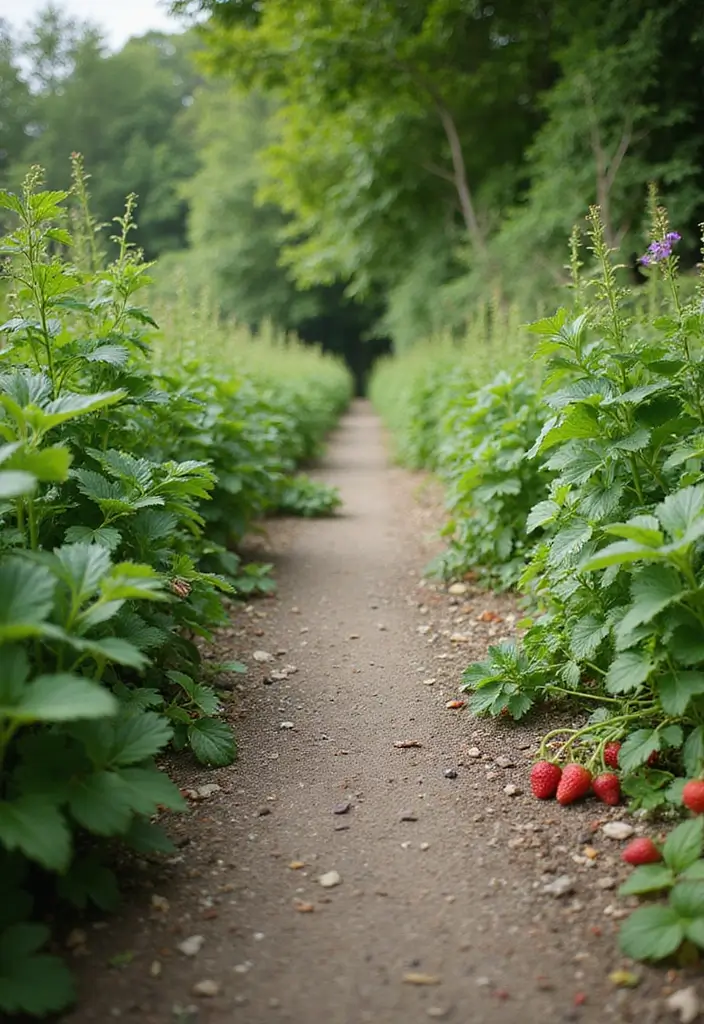
Why not make your path functional? Edible plant borders can beautifully frame your walking area while providing fresh herbs, vegetables, or even fruits.
Imagine walking on a path lined with aromatic rosemary, vibrant nasturtiums, or luscious strawberries. This approach not only promotes sustainability but also adds a flavorful touch to your garden.
Consider these tips:
– Choose plants that thrive in your climate and are hardy enough for bordering.
– Use dwarf or compact varieties to maintain the path’s accessibility.
– Rotate crops seasonally for continuous beauty and harvest!
Every stroll becomes a wonderful gardening experience.
Transform your garden path into a feast for the senses! Edible plant borders not only frame your walkway but also serve up fresh flavors – a delicious way to embrace sustainability!
10. Rustic Stone Steps
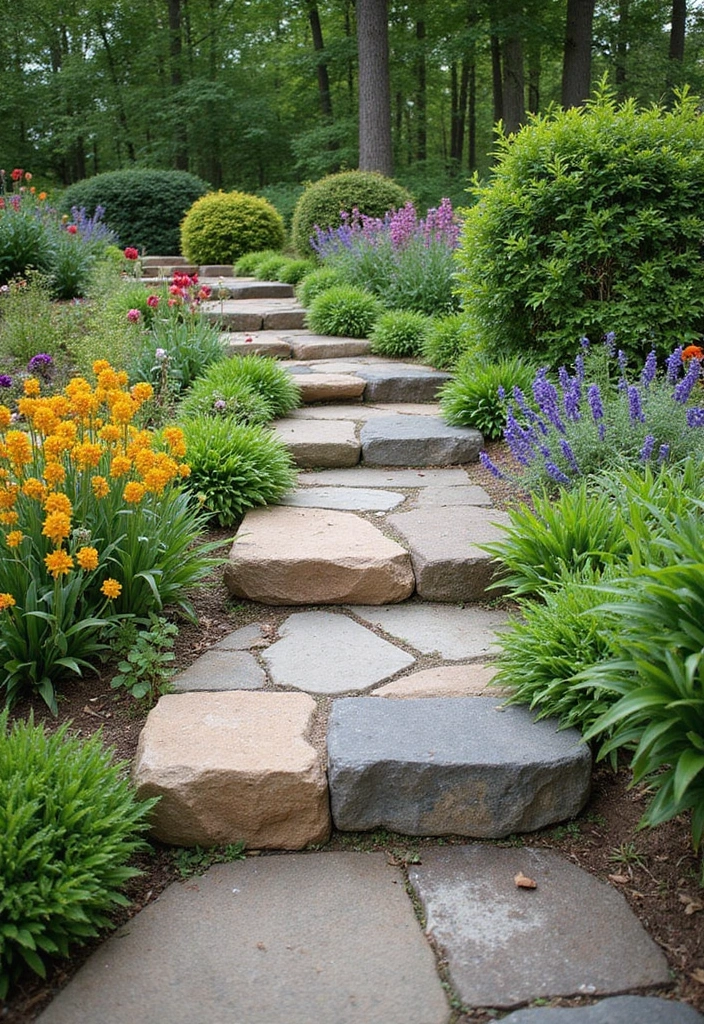
Rustic stone steps bring a rugged, natural feel to any garden path.
Utilizing large, flat stones creates a sturdy and attractive walking surface. These steps can rise gently through your garden, making the space feel welcoming and adventurous.
Some thoughts for implementing this idea:
– Select stones that harmonize with the natural surroundings.
– Ensure they are firmly placed in the ground to prevent shifting.
– Incorporate flowering plants in between for a splash of color.
The steps will guide visitors while enhancing the landscape aesthetics, creating a pathway rich in texture and charm.
11. Artistic Pavers
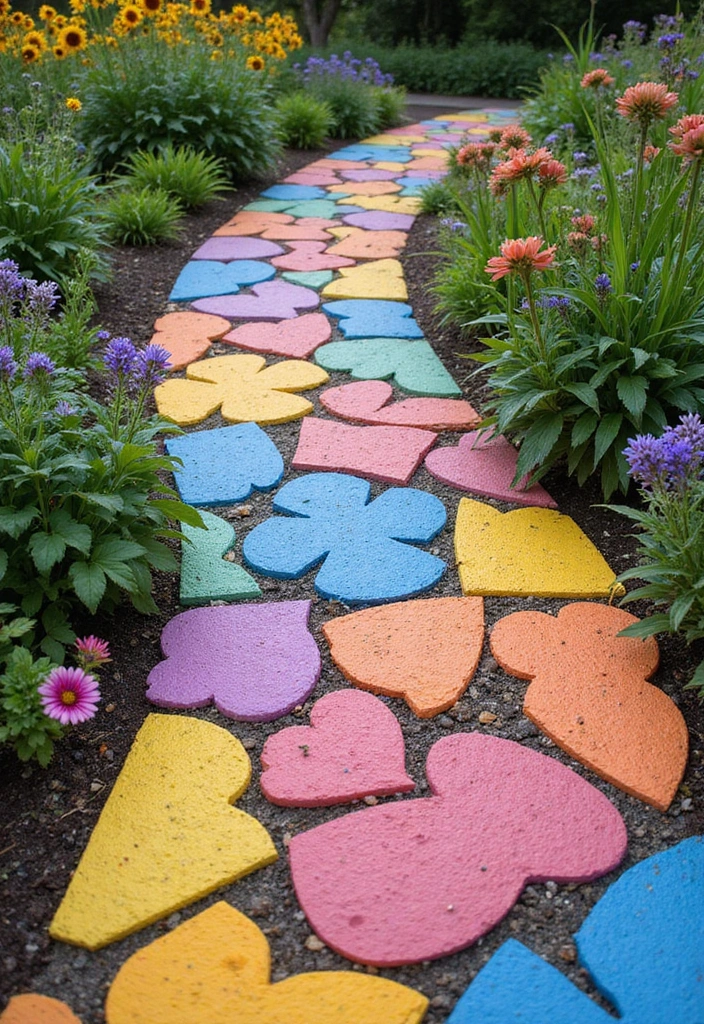
If you want to be bold, consider using artistic pavers for your garden path!
These pavers come in various shapes, sizes, and colors, allowing you to create a path that truly reflects your personality. Arrange them in abstract patterns or classic layouts—there are no limits!
Here’s what to keep in mind:
– Select durable materials that can withstand local weather conditions.
– Combine with ground cover plants for a softer edge.
– Utilize contrasting colors for a striking visual impact.
Artistic pavers turn a simple walk into a creative journey.
12. Natural Bamboo Pathways

Bring a tropical flair to your garden with bamboo pathways.
Using split bamboo poles creates a warm and inviting trail that blends seamlessly into nature. Bamboo is a sustainable choice that offers durability and flexibility, making it a fantastic alternative for eco-conscious gardeners.
Consider:
– Choosing thick poles for stability.
– Leaving spaces for draining water and allowing plants to peek through.
– Incorporating native plants alongside for an organic vibe.
Bamboo paths evoke a sense of tranquility and adventure, perfect for creating a peaceful retreat.
13. Colorful Tile Borders
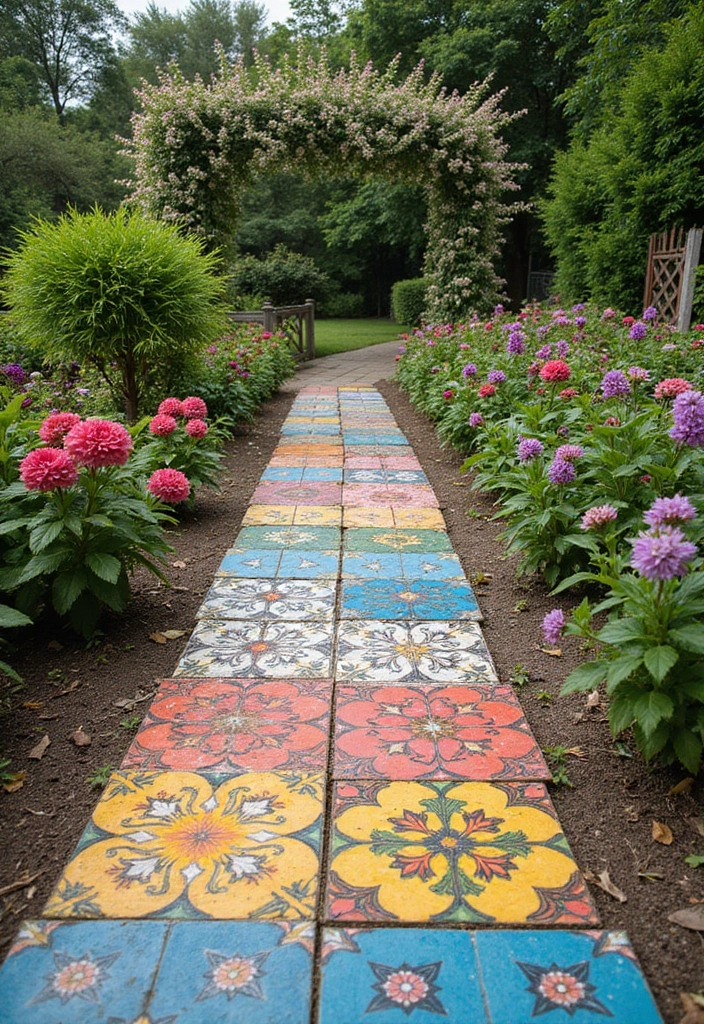
Introduce a playful element to your path with colorful tile borders.
These borders can brighten any ordinary pathway with pops of color and design. Lay tiles at the edges of your path to define the space while adding an artistic touch.
Here are some tips for success:
– Mix different patterns and colors for a mosaic effect.
– Ensure tiles are securely placed to withstand foot traffic.
– Use non-slip tiles for safety.
Colorful tile borders make your garden path a vibrant feature that beckons to be explored.
14. Concrete Garden Paths
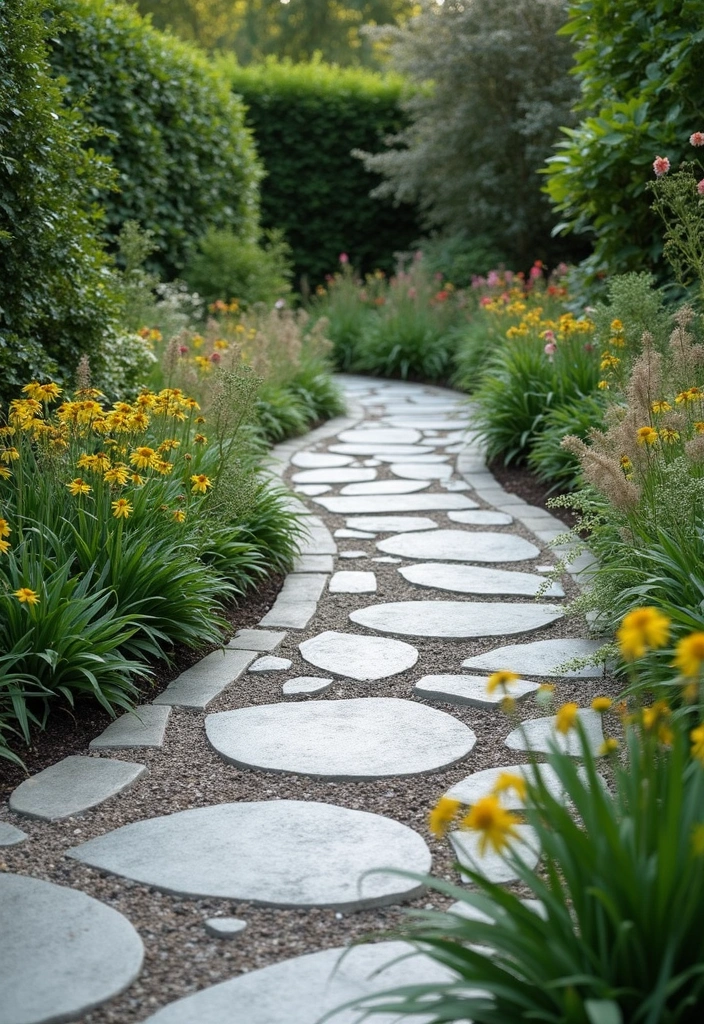
Concrete paths are a versatile and durable option for any garden.
With the ability to be molded into various shapes and stamped with patterns, concrete paths can mimic natural stone or wood, all while being robust enough to endure the elements.
Consider adding these elements:
– Use a mix of colors for a unique finish.
– Incorporate patterns for visual interest.
– Add drainage systems to prevent water pooling.
Concrete paths provide a long-lasting solution that can be customized to fit any garden aesthetic.
15. Whimsical Curved Paths
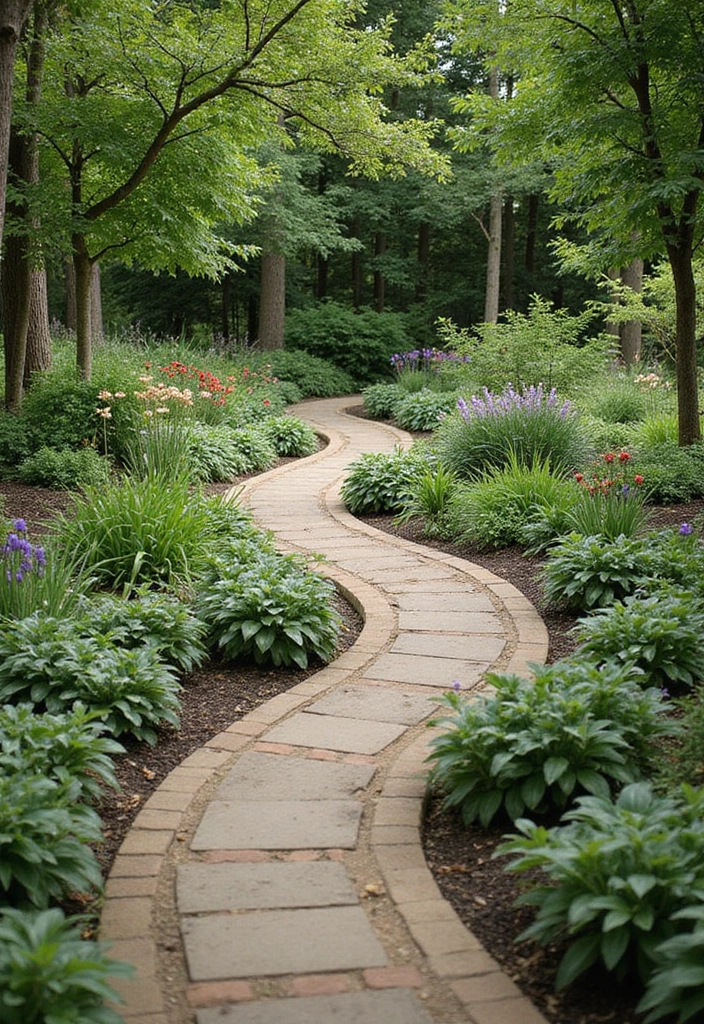
Create intrigue with whimsical curved paths.
Instead of straight lines, consider meandering paths that tease the eye and guide visitors through your garden. Curved paths create a more natural flow, making the garden feel expansive and inviting.
Things to consider:
– Use natural materials like gravel or stone to enhance the organic feel.
– Place plants strategically along the curves to frame the pathway.
– Keep the path width consistent for ease of navigation.
These paths encourage exploration and discovery, making every walk a new adventure.
16. Terracotta Tile Walks
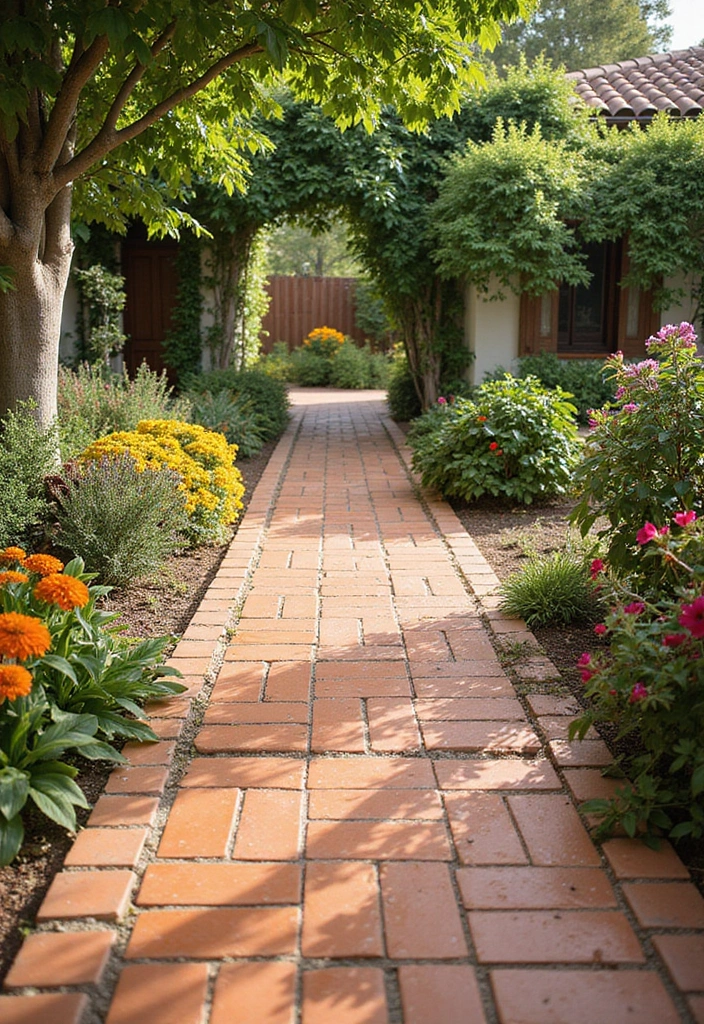
For a Mediterranean vibe, think about incorporating terracotta tiles into your garden path.
These tiles bring warmth and elegance, complementing vibrant plant life. Their earthen tones also blend beautifully with natural surroundings.
for using terracotta:
– Lay them in a staggered pattern for added visual interest.
– Pair with ornamental grasses for a stunning contrast.
– Incorporate stepping stones between the tiles for a playful twist.
A terracotta path can transport you to a sun-drenched locale, making your garden feel like a vacation spot.
17. Rustic Mulch Paths
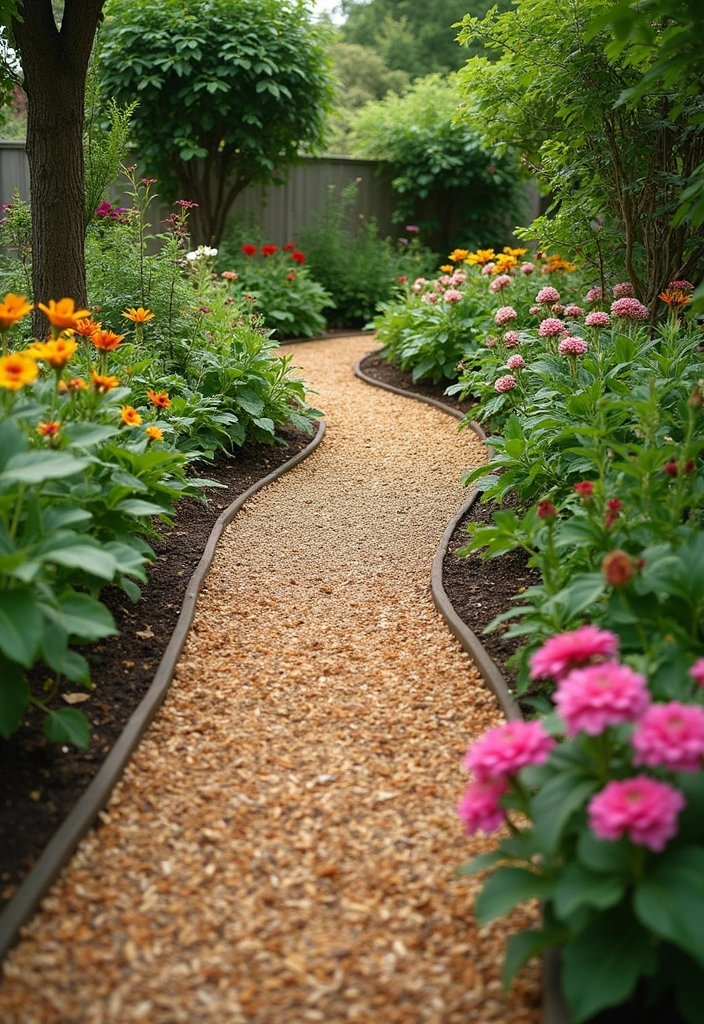
For a budget-friendly option, consider mulch paths.
These paths are not only affordable but also eco-friendly, as they use organic materials that decompose over time. Mulch paths create a soft walking surface that’s easy on the feet while enriching the soil around them.
Some suggestions include:
– Using cedar or pine mulch for a fragrant touch.
– Replenishing the mulch periodically to maintain depth.
– Mixing in stones or bricks for added structure.
Mulch paths blend seamlessly into the garden, encouraging biodiversity and enhancing the overall garden aesthetics.
18. Sandstone Slab Paths
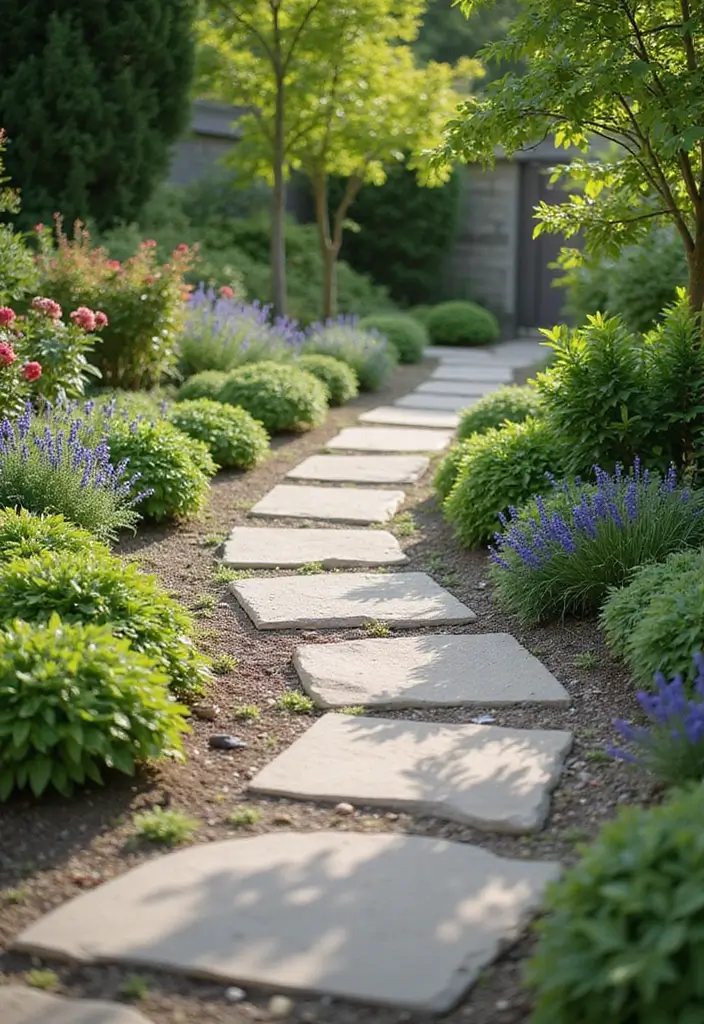
Sandstone slabs offer a natural and timeless look for your garden paths.
These slabs are versatile, easy to install, and they blend beautifully with the surrounding environment. Their natural colors complement greenery, creating a tranquil atmosphere.
Things to keep in mind:
– Choose slabs of varying sizes for a dynamic layout.
– Space them out to allow for grass or creeping plants to weave between.
– Seal them to protect against moisture damage.
The beauty of sandstone paths is in their natural charm, making every walk feel like an escape into nature.
Transform your garden paths with sandstone slabs – where natural beauty meets effortless charm. Embrace the tranquility as greenery weaves through your walkway, creating a serene escape right in your backyard!
19. Upcycled Material Paths
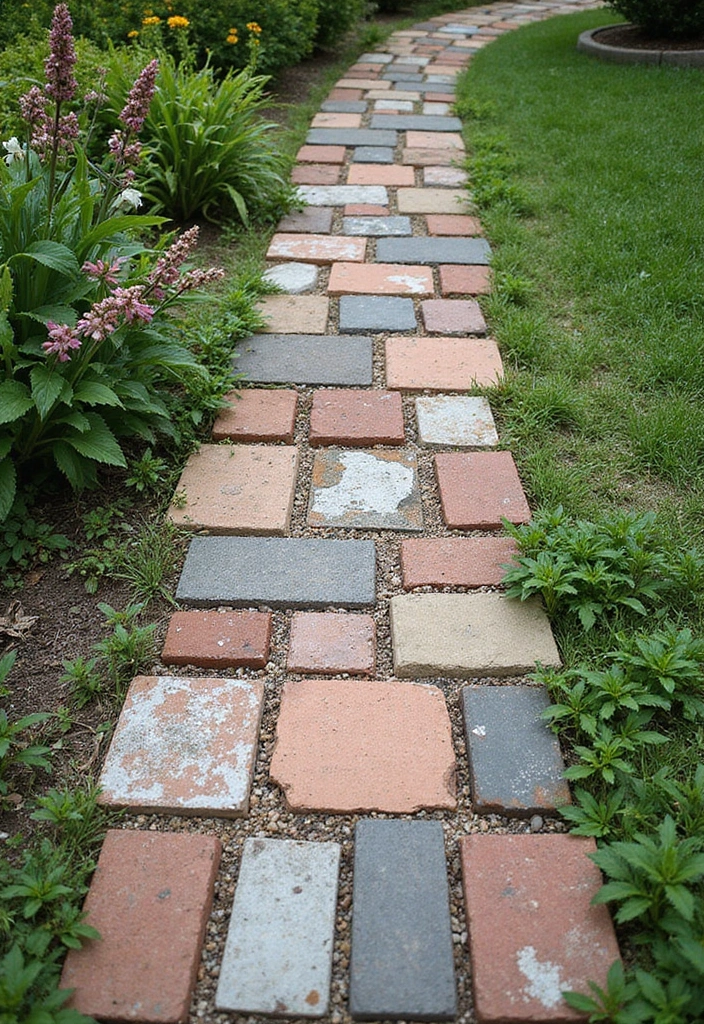
Upcycling materials for garden paths not only promotes sustainability but also encourages creativity.
Think about using broken bricks, old tiles, or even wood scraps to create a patchwork path that reflects your personality. This method allows you to tell a story through your garden while minimizing waste.
Ideas to consider:
– Collect materials over time to create a unique layout.
– Mix and match colors and textures for a vibrant look.
– Let grass or moss grow in between for a natural feel.
An upcycled path becomes a conversation piece, inspiring others to think outside the box.
20. Grassy Pathways
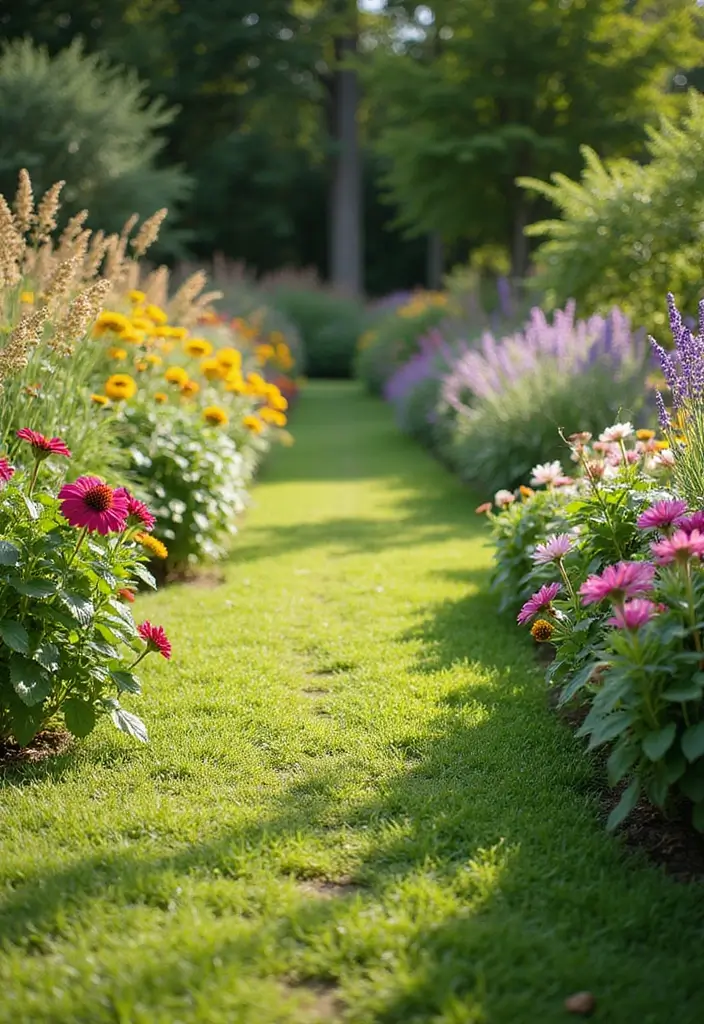
A grassy pathway offers a soft, natural feel that’s perfect for casual strolls.
Incorporating grass into your pathways allows you to maintain that lush garden vibe while making the environment feel more inviting. This type of pathway is also easy to install and can be shaped to fit your garden’s flow.
Considerations include:
– Mowing the grass regularly to keep it looking neat.
– Mixing in stepping stones for foot traffic durability.
– Choosing low-maintenance grasses that require less water.
A grassy path can make your garden feel like a wild sanctuary, where nature thrives.
21. Mosaic Stone Pathways
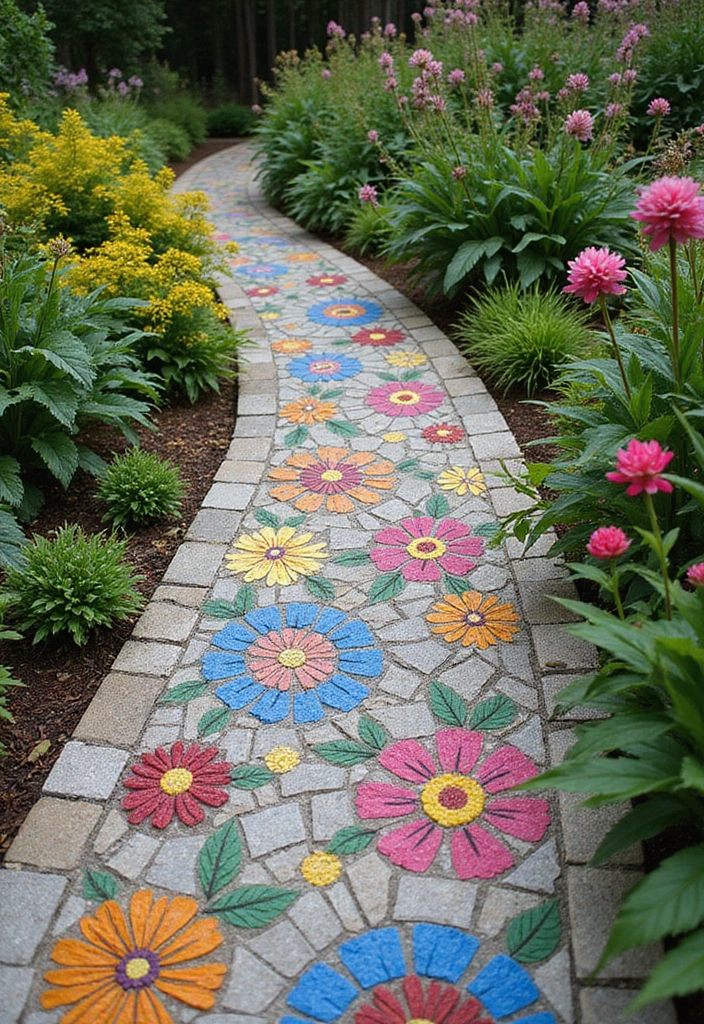
Mosaic stone pathways add artistic flair and visual interest to your garden.
Utilizing stones of various colors and shapes allows you to create stunning designs, defining a unique character that sets your garden apart. Whether it’s a simple geometric pattern or something more complex, mosaic paths are a delightful way to express creativity.
for crafting mosaic paths:
– Plan your design on paper first.
– Use a binding agent to keep stones in place.
– Leave small spaces for drainage.
These paths attract attention and admiration, making your garden a showcase of creativity.
22. Casual Pebble Paths
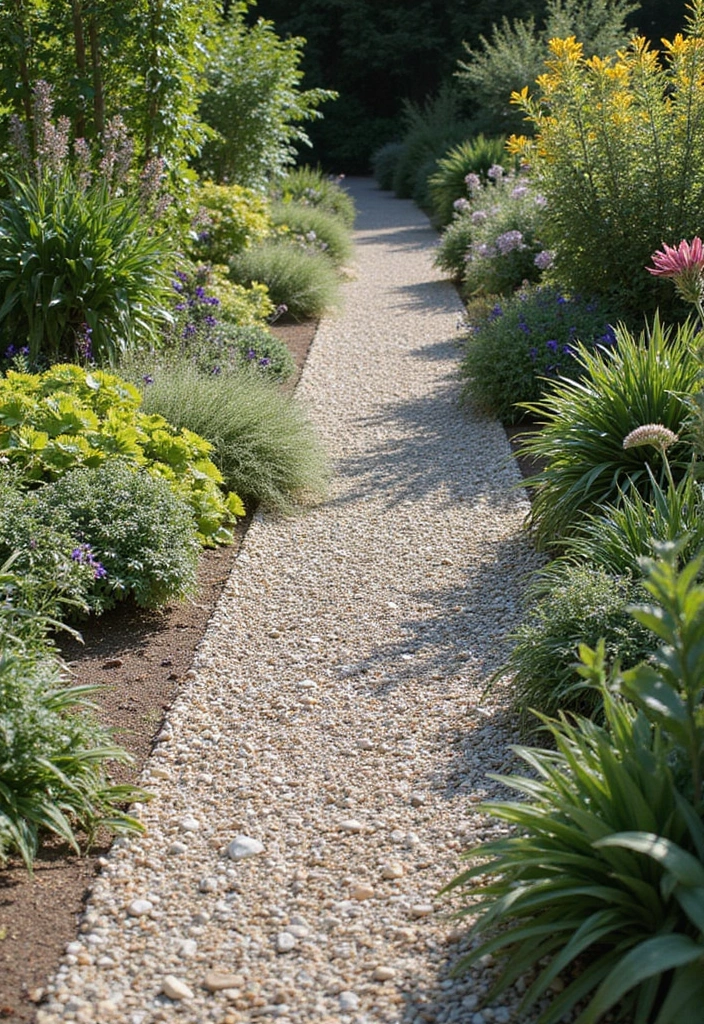
For a relaxed, natural look, pebble paths are a perfect choice.
Utilizing small pebbles creates a soft surface underfoot while allowing for great drainage. This type of pathway is also straightforward to create and maintain. You can choose from a variety of colors and sizes to suit your aesthetic.
Consider these points:
– Use edging materials to keep the pebbles contained.
– Incorporate larger stones for visual interest.
– Add native plantings at the borders for extra charm.
Pebble paths create a laid-back feel while enhancing your garden’s beauty and sustainability.
23. Creative Cinder Block Paths
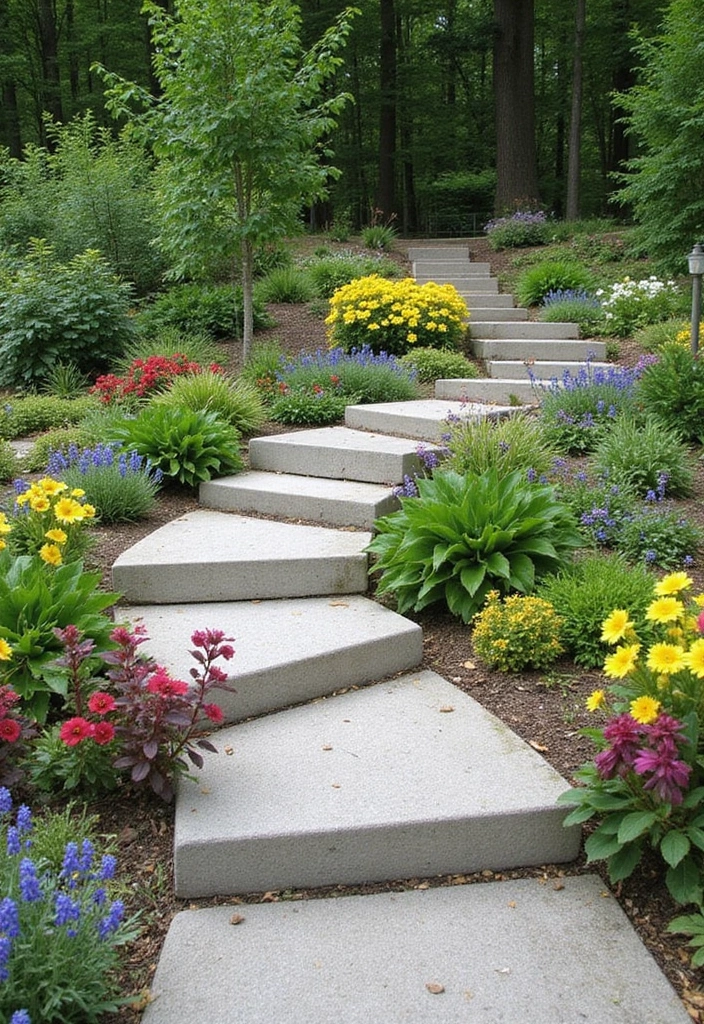
Cinder blocks offer a modern twist for your garden paths.
These blocks can be arranged in interesting patterns, filled with soil and planted with moss or ground cover for an innovative look. This idea is practical, sustainable, and cost-effective, allowing you to create an eye-catching pathway effortlessly.
Some tips include:
– Choose blocks that are uniform for a clean look.
– Fill with colorful flowers or plants for a vibrant touch.
– Use paint or stains to customize the blocks for a personal flair.
Cinder block paths provide a contemporary edge while promoting green practices.
24. Recycled Glass Aggregate Paths
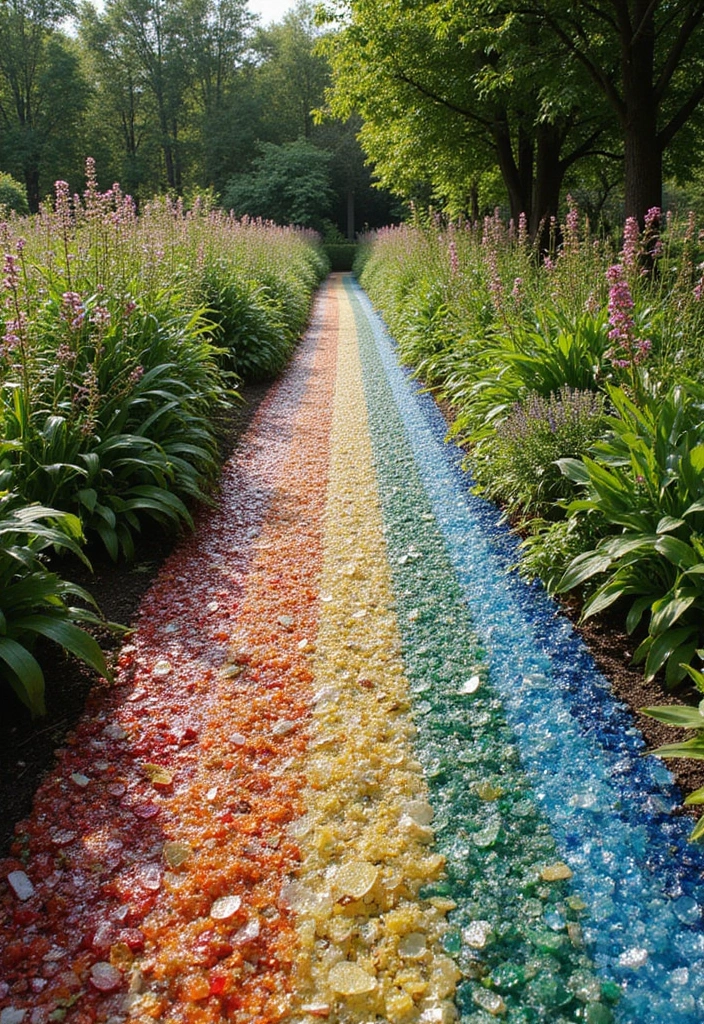
For a sparkling touch, try recycled glass aggregate paths.
These paths utilize crushed recycled glass combined with stone or cement to create a visually stunning and eco-friendly surface. The glass catches the light, adding a unique sparkle to your garden.
Considerations for construction:
– Ensure the glass is properly crushed and safe to walk on.
– Mix with natural stone for added texture and durability.
– Use proper edging to contain the glass aggregate.
These paths are not only beautiful but also promote recycling, making them a conscientious choice for your garden.
Transform your garden paths with recycled glass aggregate—where sustainability sparkles! Embrace eco-friendly beauty while adding a unique flair to your outdoor space.
25. Slatted Wood Pathways

Slatted wood pathways offer a modern, airy feel to any garden.
Using narrow slats of wood spaced apart allows grass or ground cover to grow between them, softening the path while creating a fresh look. This design promotes airflow and reduces water pooling.
Points to consider:
– Select durable, weather-resistant wood.
– Ensure slats are evenly spaced for uniformity.
– Use a sealant to protect against moisture.
Slatted wood paths provide a soothing balance between natural and contemporary styles.
“Creating a slatted wood pathway isn’t just about style; it’s about harmony with nature. Let the grass peek through and breathe life into your garden path!”
26. Fern-Lined Paths
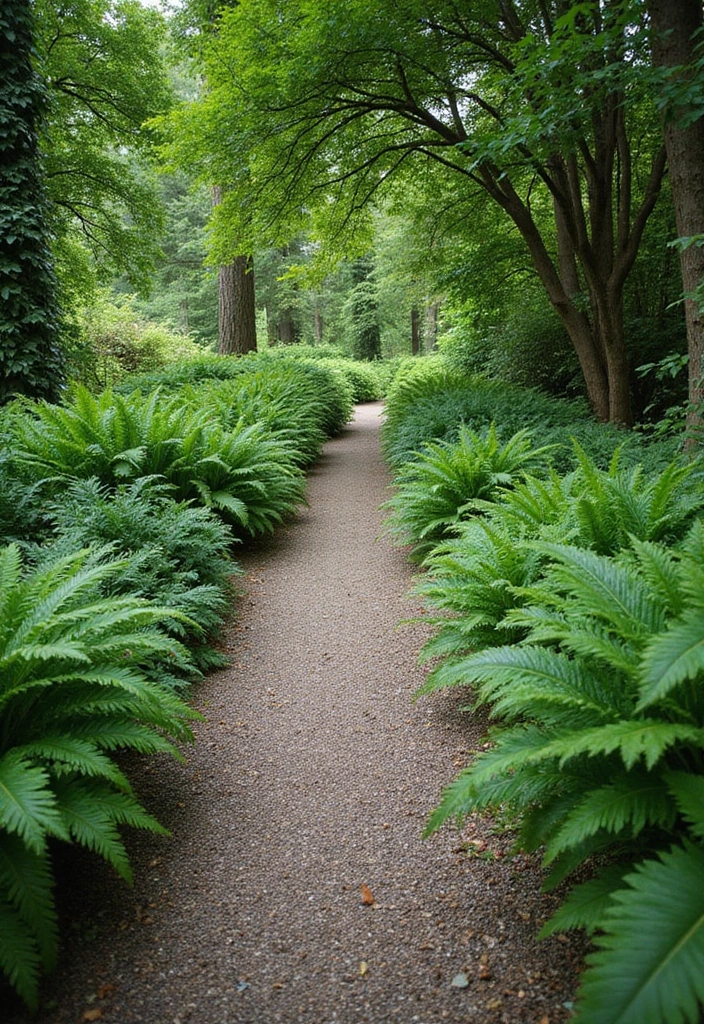
For a lush, tropical feel, consider fern-lined paths.
These paths can be simple gravel or stone, lined with vibrant ferns on either side, creating a visual feast that feels like a magical forest. The texture of the ferns contrasts beautifully with hard surfaces, creating an inviting environment.
Some suggestions:
– Choose shade-loving ferns for areas with less sunlight.
– Incorporate different sizes and varieties for depth.
– Maintain the ferns regularly for a tidy look.
A fern-lined path can feel like a secret garden, drawing visitors into its lush embrace.
27. Seasonal Flower Paths

Why not make your path bloom? Seasonal flower paths integrate flowering plants that change with the seasons, ensuring your path looks beautiful year-round.
Consider planting bulbs for spring, vibrant annuals for summer, and colorful foliage for fall. This approach not only enhances the garden aesthetics but also provides an ever-changing view.
Ideas to consider:
– Choose flowers that thrive in your local climate.
– Plan for plants that will complement each other in color and growth.
– Incorporate stepping stones for easy navigation.
Seasonal flower paths create a sense of excitement and anticipation, showcasing nature’s beauty.
28. Whimsical Log Pathways
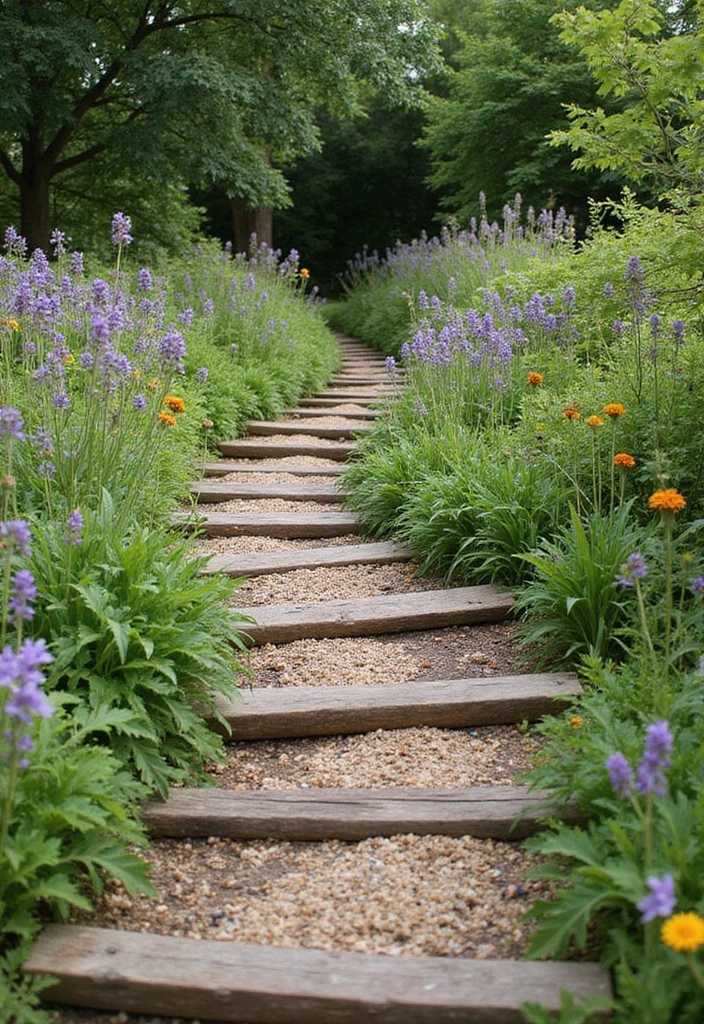
For a charming touch, consider log pathways.
Using tree trunks or large branches set on the ground creates a playful, rustic feel. This method is sustainable, utilizing natural materials that blend into the garden seamlessly.
Points to keep in mind:
– Ensure the logs are stable and safe for walking.
– Pair with wildflowers for a natural look.
– Sand down rough edges for safety.
Log pathways invite a woodland spirit into your garden, making every step feel like an adventure.
29. Drought-Resistant Stone Paths

As water conservation becomes more essential, drought-resistant stone paths are a fantastic option.
Utilizing stones that require minimal maintenance, this path design combines practicality with beauty, ensuring your path remains attractive even in arid conditions.
Some suggestions include:
– Choosing native stone varieties that thrive in your region.
– Incorporating desert plants along the edges for added beauty.
– Ensuring proper drainage for heavy rains.
These paths offer a sustainable solution while enhancing your garden’s overall look.
30. Vintage Tile Pathways
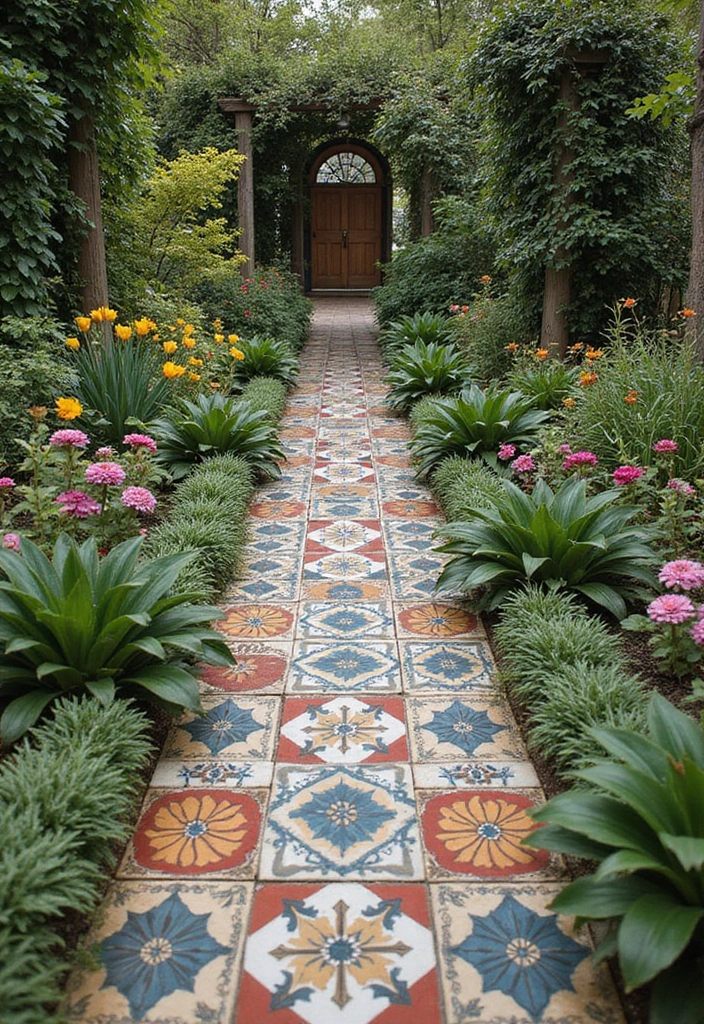
Vintage tile pathways bring a sense of nostalgia and charm to your garden.
Using salvaged vintage tiles allows you to create a unique, colorful path that tells a story. The variety of patterns and textures available can transform your path into a work of art.
Considerations include:
– Ensure tiles are in good condition and safe for foot traffic.
– Mix different patterns and colors for a delightful visual experience.
– Arrange tiles with spaces for plants to pop through.
Vintage tile paths are a fabulous way to celebrate history while adding beauty to your garden.
Conclusion
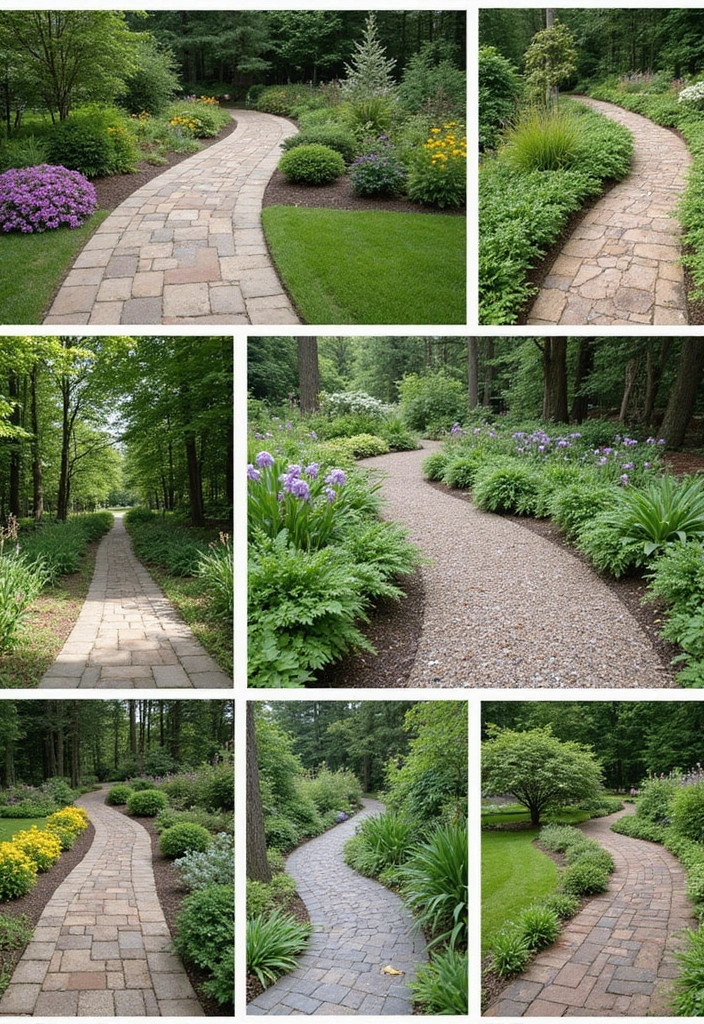
These 30 creative garden path ideas showcase the beauty and potential of sustainable landscape design.
From recycled materials to living paths, each option invites you to personalize your garden while respecting our planet.
Explore the possibilities and let your garden paths guide you to a world of beauty and tranquility.
Frequently Asked Questions
What Are Some Sustainable Materials I Can Use for My Garden Path?
Great question! There are plenty of sustainable materials you can use to create a beautiful garden path.
Consider using recycled wood planks, reclaimed bricks, or upcycled tiles. These options not only add charm but also promote eco-friendly practices by reducing waste. Additionally, natural stones and gravel are fantastic for drainage and can create a lovely rustic look.
How Can I Incorporate Living Plants into My Garden Path?
Incorporating living plants into your garden path can create a stunning and functional design!
Consider using ground cover plants like thyme or creeping phlox that can withstand foot traffic. This not only adds beauty but also helps with soil erosion and provides a pleasant scent as you walk. Just ensure they are well-maintained and suited to your climate for the best results!
What Are Some Creative Ways to Light Up My Garden Path?
Lighting can transform your garden path into a magical space at night!
Try using glass jar lights or solar-powered lanterns for an eco-friendly option that adds charm. You can also create a whimsical look with fairy lights strung along the path. Make sure to position lights strategically to highlight the path without being too harsh, ensuring safety and enhancing your garden aesthetics.
How Do I Choose the Right Design for My Garden Path?
Choosing the right design for your garden path is all about your personal style and the overall landscape design of your garden!
Consider factors such as the materials you love, the colors that complement your plants, and the function of the path. For a casual vibe, opt for pebble paths or grassy pathways. If you prefer a more contemporary look, consider artistic pavers or concrete paths that can be molded into various shapes. Don’t forget to think about maintenance and drainage too!
Can I Create a Garden Path on a Budget?
Absolutely! Creating a stunning garden path doesn’t have to break the bank.
Consider using mulch for a budget-friendly option, or get creative with cinder blocks or reclaimed materials. You can also look for vintage tiles at thrift stores to give your path a unique flair. With a little creativity and resourcefulness, you can design an inviting outdoor pathway that fits your budget and style!
